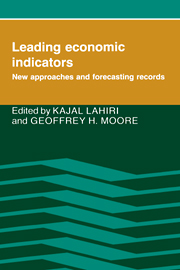Book contents
- Frontmatter
- Contents
- Preface
- List of contributors
- 1 Introduction
- PART I NEW CONCEPTS AND METHODS
- PART II FORECASTING RECORDS AND METHODS OF EVALUATION
- 9 Forecasting cyclical turning points: The record in the past three recessions
- 10 Turning point predictions, errors, and forecasting procedures
- 11 Forecasting peaks and troughs in the business cycle: On the choice and use of appropriate leading indicator series
- 12 Using a consensus of leading economic indicators to find the right ball park for real GNP forecasts
- 13 Some Australian experience with leading economic indicators
- 14 Turning point prediction with the composite leading index: An ex ante analysis
- 15 Forecasting recessions under the Gramm-Rudman-Hollings law
- 16 Leading indicators of inflation
- PART III NEW ECONOMIC INDICATORS
- Index
12 - Using a consensus of leading economic indicators to find the right ball park for real GNP forecasts
Published online by Cambridge University Press: 05 June 2012
- Frontmatter
- Contents
- Preface
- List of contributors
- 1 Introduction
- PART I NEW CONCEPTS AND METHODS
- PART II FORECASTING RECORDS AND METHODS OF EVALUATION
- 9 Forecasting cyclical turning points: The record in the past three recessions
- 10 Turning point predictions, errors, and forecasting procedures
- 11 Forecasting peaks and troughs in the business cycle: On the choice and use of appropriate leading indicator series
- 12 Using a consensus of leading economic indicators to find the right ball park for real GNP forecasts
- 13 Some Australian experience with leading economic indicators
- 14 Turning point prediction with the composite leading index: An ex ante analysis
- 15 Forecasting recessions under the Gramm-Rudman-Hollings law
- 16 Leading indicators of inflation
- PART III NEW ECONOMIC INDICATORS
- Index
Summary
There is a practical reason for being interested in consensus forecasts, since they are more accurate than most predictions and will sometimes have a better track record than virtually all forecasting systems based on individual records or parsimonious models (Moore, 1969, McNees, 1987). In this chapter I illustrate the superiority of a consensus approach by using a diffusion index and the downness properties of other leading economic indicators to find the right ball park for real GNP forecasts and improve our ability to identify economic recessions before their occurrence.
Finding the right ball park
The starting point for what is hoped will be better forecasts is the discovery that the distribution of the average annual growth rates for real GNP has been trimodal. Since 1948 there have been eight instances when the GNP growth rate was zero or negative; seventeen instances when the growth rate was in the 1.7 to 4.1 percent range; and fourteen years when the growth rate was in the 4.7 to 10.3 percent range. The gaps between these poor, mediocre, and super growth rate distributions can probably be attributed to interactions between the multiplier and accelerator principles.
From 1955 to 1980 the average annual percentage change in real gross private fixed domestic investment was approximately equal to three times the average growth rate for real GNP minus six percentage points. This accelerator relationship implies that real GNP must increase at an average rate of about 2 percent per year just to keep investment from falling and having a deleterious feedback effect on the rest of the economy.
- Type
- Chapter
- Information
- Leading Economic IndicatorsNew Approaches and Forecasting Records, pp. 197 - 210Publisher: Cambridge University PressPrint publication year: 1991
- 1
- Cited by



